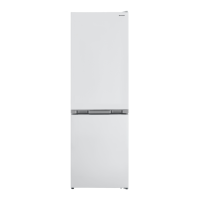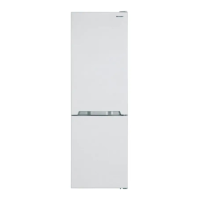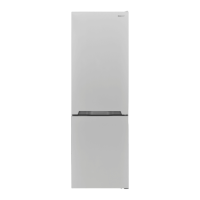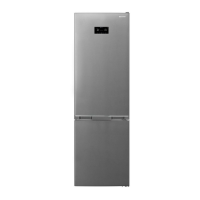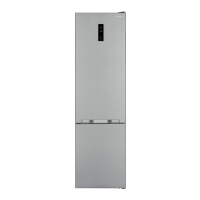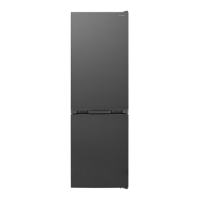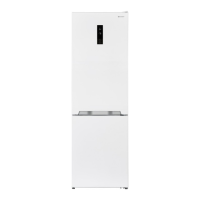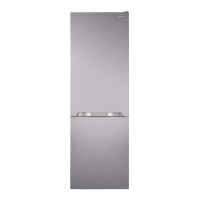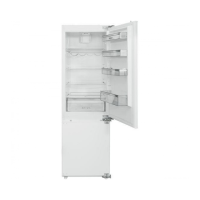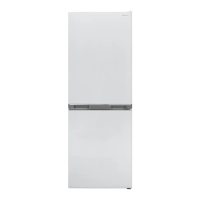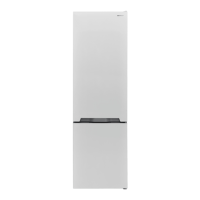STORING FOOD
Refrigeration reduces the rate of food spoilage.
To maximize the shelf life of perishable food products,
ensure that the food is of the freshest possible quality. The
following is a general guide to help promote longer food
storage.
Fruit / Vegetables
To minimize moisture loss, fruit and vegetables should be
loosely enclosed in a plastic material e.g. wrap, bags (do
not seal) and place in the vegetable crisper.
Dairy Products & Eggs
• Most dairy products have a use by date on the outer
packaging which informs the recommended temperature
and shelf life of the product.
• Eggs should be stored in the Egg pocket.
Meats / Fish / Poultry
• Place on a plate or dish and cover with paper or plastic
wrap.
• For larger cuts of meat, fish, or poultry, place to the rear
of the shelves.
• Ensure all cooked food is wrapped securely or placed in
an airtight container.
NOTE :
• Evenly place the food on the shelves to allow
the cooling air to circulate efficiently.
• Hot foods should be cooled before storing.
Storing hot foods increases the
temperature in the unit and increases the
risk of food spoilage.
• Do not block the outlet and inlet of the cool
air circulating circuit with foods or
containers; otherwise the foods will not be
evenly cooled throughout the refrigerator.
• Do not place food directly in front of cold
air outlet. This may lead to the food freezing.
FOR BEST FREEZING
• Quality of foods should be fresh.
• Freeze small quantities of food at a time to freeze them
quickly.
• Food should be properly stored or covered and the air
should be removed to seal tightly.
• Evenly place the food in the freezer.
• Label bags or containers to keep an inventory of freezing
food.
BEFORE YOU CALL FOR SERVICE
Before you call for service, check the following points.
• Keep the door securely closed.
in
out
IF YOU STILL REQUIRE SERVICE Refer to your nearest service agent approved by SHARP.
Problem Solution
The outside of a cabinet is hot
when touched.
It is normal. The hot pipe is in the cabinet in order to prevent dew generation.
When there is refrigerator noise.
•
Loud noise produced by the compressor when operation starts
--- Sound becomes quieter after a while.
•
Loud noise produced once a day by the compressor
--- Operating sound produced immediately after automatic defrost operation.
•
Sound of flowing fluid (gurgling sound, fizzing sound)
--- Sound of refrigerant flowing in pipes (sound may become louder from time
to time).
•
Cracking or crunching sound, Squeaking sound --- Sound produced
by expansion and contraction of inner walls and internal parts during cooling.
Frosting or dew generation occurs
inside or outside the refrigerator.
This may occur in one of the following cases. Use a wet cloth for wiping frost and
a dry cloth for wiping dew.
• When the ambient humidity is high.
• When the door is frequently opened and closed.
• When foods containing plenty of moisture are stored. (Wrapping is required.)
The foods in the refrigerator
compartment freeze.
• Is the refrigerator operated for a long time with REFRIGERATOR TEMP. CONTROL
set at MAX?
• Low ambient temperature may cause placed foods to freeze even if
REFRIGERATOR TEMP. CONTROL is set to MIN.
It smells in the compartment. • Wrapping is required for the foods with strong smell.
• Deodorizing unit cannot remove all of smell.
Door alarm does not stop.
•
If the door alarm does not stop after closing.
•
Check the refrigerator door is closed surely.
Contact the Sharp service center for service.
Method of stopping the door alarm temporarlly.
Adjust refrigerator temp.control knob as following steps.
(Adjust
1 ~ 3 within 20 seconds)
1
Adjust to MIN
2
Adjust to MAX
3
Return to MED
The door alarm will sound again after approximately 2 days.
1
2
3
Coldest
NOTE :
It is normal for the refrigerator to produce the following sounds.
13
